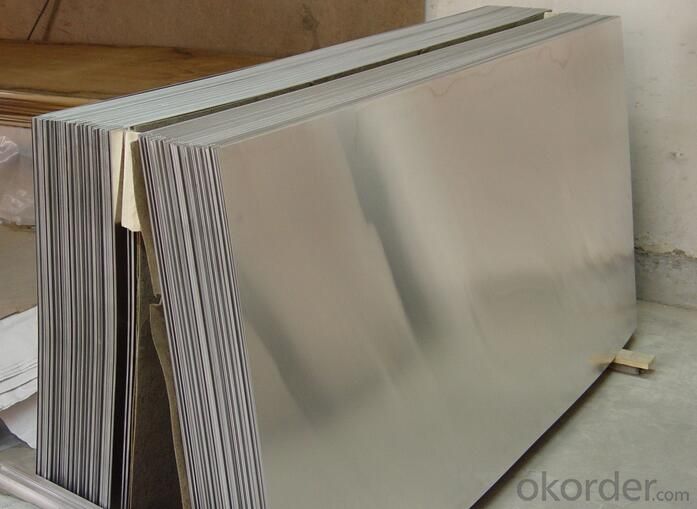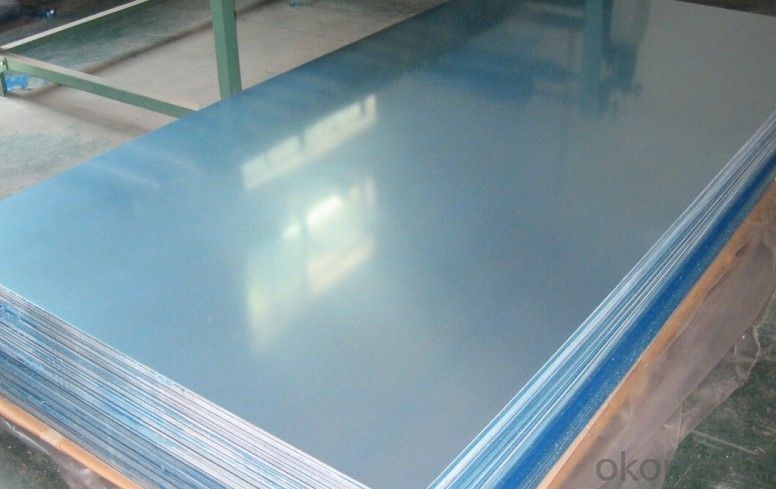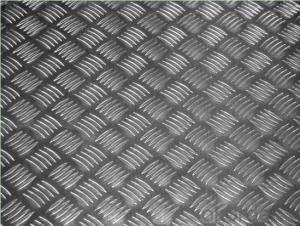5 Bars Decorative Aluminum Sheet Skid Resistance
- Loading Port:
- China main port
- Payment Terms:
- TT OR LC
- Min Order Qty:
- 5 m.t.
- Supply Capability:
- 500 m.t./month
OKorder Service Pledge
OKorder Financial Service
You Might Also Like
Item specifice
5 bars decorative aluminum sheet skid resistance
ALLOY : AA1***(AA1050,AA1060,AA1070,AA1100etc)
AA3***(AA3003,AA3004,AA3005,AA3105etc)
AA5***(AA5052 etc)
TEMPER:H14,H18,H24,H26,H32
THICKNESS:0.2mm-20mm
WIDTH:10mm-1500mm
EMBOSSED PATTERNS : Diamond, stucoo,bars etc
STANDARD: GB/T3880-2006
Special specification is available on customer's requirement
Product Description
Goods name | Aluminum plate |
alloy | Yes |
Plance of origin | China |
Quality | Prime quality |
Certificate | ISO9001 |
Grade | 3000 Series |
Thickness | 0.3-150mm |
Type | Plate |
Width | 300-1950mm |
Model number | 3003,3004,3005,3014,3105 |
Surface | Mill finish |
Temper | O-H112 |
Ensure | we can supply customers' with different specifications of the highest quality and lowest price. Sincerely welcome to contact us for the future details if any item interest you ,and we will make every effort to assure that your requirements will be satisfied,and we hope to establish long-term business relations with you on the basis of the equality and mutual benefit. |


- Q:Which kind of glue can bond hard shell plastic and iron sheet or aluminum sheet?
- You can buy the glue for bonding wood in hardware shop, 402 or 502 are all ok.
- Q:how much should the current be adjusted when I use pulse aluminum welding machine to weld 0.7 aluminum sheet?
- 60-70A current is enough for 0.7 aluminum sheet,the key poiny is that the thin sheet should be bonded with iron sheet or other assistant cooling device when you weld it, or it will be burned through.
- Q:What are the common thicknesses of aluminum sheets used in transportation industry?
- Aluminum sheets are widely utilized in the transportation sector for various purposes due to their lightweight, durability, and ability to resist corrosion. In this industry, the thickness of aluminum sheets typically falls within the range of 0.025 inches (0.63 mm) to 0.125 inches (3.18 mm). When it comes to automotive body panels, which necessitate a balance between weight reduction and structural integrity, the preferred thickness of aluminum sheets is usually between 0.040 inches (1.02 mm) and 0.063 inches (1.6 mm). These particular thicknesses ensure sufficient strength while effectively reducing the overall weight of the vehicle compared to steel counterparts. In the aerospace field, where weight reduction is of utmost importance, thinner aluminum sheets are commonly employed. Typically, thicknesses ranging from 0.025 inches (0.63 mm) to 0.040 inches (1.02 mm) are used in the construction of aircraft structures, including wings, fuselage panels, and interior components. It is important to note that the specific thicknesses of aluminum sheets in the transportation industry may vary depending on the particular application, regulatory requirements, and design factors. Thus, it is crucial to consult the relevant industry standards and specifications for accurate information regarding the recommended thicknesses for different transportation applications.
- Q:Is plastic or alumium container more harmful to store food in if it does get to the food while heating.
- Neither is great, but aluminum is worse (especally when heated). Also you can't put aluminum in the microwave since it sparks (technically it should not be used for cooking), but plastic leaches stuff info food, especially if it's via ceranwrap on top (in a microwave). Storing things in platic tupperware in the fridge is fine since the temperatures are cold enough that no reactions can happen, but for cooking and eating, ceramic is preferable. Aluminum on the other hand should just be avoided (for baking pyrex glass/ceramic is better). Out of all the forms of aluminum, aluminum foil is the most likely to leech stuff. Hope that helps!
- Q:What is the maximum width available for aluminum sheets?
- The maximum width of aluminum sheets can differ depending on the manufacturer and specific specifications. Typically, aluminum sheets can be found in widths up to 72 inches or 1.83 meters. It should be emphasized that certain manufacturers may provide wider choices for specialized purposes. Furthermore, personalized dimensions can be acquired by placing specific orders, providing more freedom in selecting the desired width.
- Q:What are the weight limitations for aluminum sheets in different applications?
- The weight limitations for aluminum sheets vary depending on the specific application. Factors such as the thickness, alloy, and intended usage play a significant role in determining the maximum weight that aluminum sheets can support. It is essential to consult the manufacturer's specifications or engineering professionals for the precise weight limitations in different applications.
- Q:What are the different methods of joining aluminum sheets without welding?
- There are several methods of joining aluminum sheets without welding. 1. Adhesive bonding: This method involves using an adhesive to bond two aluminum sheets together. The adhesive creates a strong and durable bond, and it can be applied in various ways such as tapes, liquid adhesives, or films. Adhesive bonding is a popular choice as it provides a clean and aesthetically pleasing finish. 2. Mechanical fastening: This method involves using mechanical fasteners such as screws, rivets, or bolts to join aluminum sheets together. These fasteners provide a strong and reliable connection and are commonly used in industries where disassembly or repair is required. Mechanical fastening is also relatively easy to implement and does not require any additional equipment. 3. Clinching: Clinching is a cold-forming process that involves joining aluminum sheets by using a punch and die to create a strong interlock between them. This method is suitable for thin aluminum sheets and offers good mechanical strength. Clinching is a cost-effective alternative to welding, as it does not require any additional materials or heat. 4. Friction stir welding: Although not technically welding, friction stir welding is a solid-state joining process that uses a rotating tool to generate frictional heat between the aluminum sheets. As the tool moves along the joint, it creates a plasticized region that is then consolidated to form a strong bond. Friction stir welding is mainly used for joining thicker aluminum sheets and offers excellent mechanical properties. 5. Folded joints: This method involves folding the edges of two aluminum sheets together to create a joint. The folded joint can be secured by using adhesives, mechanical fasteners, or a combination of both. Folded joints provide good strength and stiffness, and they are commonly used in applications where a seamless appearance is desired. These methods offer various advantages and can be chosen based on the specific requirements of the project, including the desired strength, appearance, and ease of implementation.
- Q:What is the typical lead time for ordering aluminum sheets?
- The typical lead time for ordering aluminum sheets can vary depending on various factors such as the supplier, the quantity of sheets ordered, and the current demand for aluminum. However, in general, lead times for ordering aluminum sheets can range from a few days to several weeks. For standard-sized aluminum sheets that are readily available in stock, the lead time is usually shorter, typically ranging from a few days to a week. This is because suppliers often have these common sizes in their inventory and can ship them out quickly. On the other hand, if you require custom-sized aluminum sheets or a large quantity that is not readily available, the lead time may be longer. In such cases, the supplier may need to source the aluminum, cut it to the desired size, and process any necessary treatments or finishes. This process can take several weeks, especially if the supplier has a high volume of orders or if the aluminum needs to be imported. It is important to communicate with the supplier to determine the specific lead time for your order. They will be able to provide you with an estimated timeframe based on their current production capacity, stock availability, and any other factors that may impact the lead time.
- Q:Hey.How come iron rust and aluminium does not?DETAILED ANSWER PLEASE.I want to understand this...THANKS.
- Aluminum corrodes but it does not rust. Rust refers only to iron and steel corrosion. Aluminum is actually very prone to corrosion. However, aluminum corrosion is aluminum oxide, a very hard material that actually protects the aluminum from further corrosion. Aluminum oxide corrosion also looks a lot more like aluminum, so it isn't as easy to notice as rusted iron. When iron corrodes the color changes and it actually expands. This expanding and color change can produce large red flakes that we all know as rust. Unlike aluminum oxide, the expanding and flaking off of rust exposes new metal to further rusting. This why it is so important to provide a barrier so rust doesn't start.
- Q:Are aluminum sheets suitable for chemical storage containers?
- Chemical storage containers are usually not appropriate for aluminum sheets. Despite aluminum's reputation for being resistant to corrosion, it can still interact with certain chemicals, causing the container to deteriorate and potentially contaminate the substance being stored. In addition, aluminum is a relatively fragile metal and may not offer sufficient strength and durability for the long-term storage of hazardous chemicals. It is recommended to utilize materials that are explicitly designed for chemical storage, such as high-density polyethylene (HDPE), polypropylene (PP), or stainless steel, as they provide exceptional resistance to chemicals and structural stability.
1. Manufacturer Overview |
|
|---|---|
| Location | |
| Year Established | |
| Annual Output Value | |
| Main Markets | |
| Company Certifications | |
2. Manufacturer Certificates |
|
|---|---|
| a) Certification Name | |
| Range | |
| Reference | |
| Validity Period | |
3. Manufacturer Capability |
|
|---|---|
| a)Trade Capacity | |
| Nearest Port | |
| Export Percentage | |
| No.of Employees in Trade Department | |
| Language Spoken: | |
| b)Factory Information | |
| Factory Size: | |
| No. of Production Lines | |
| Contract Manufacturing | |
| Product Price Range | |
Send your message to us
5 Bars Decorative Aluminum Sheet Skid Resistance
- Loading Port:
- China main port
- Payment Terms:
- TT OR LC
- Min Order Qty:
- 5 m.t.
- Supply Capability:
- 500 m.t./month
OKorder Service Pledge
OKorder Financial Service
Similar products
New products
Hot products
Related keywords





























